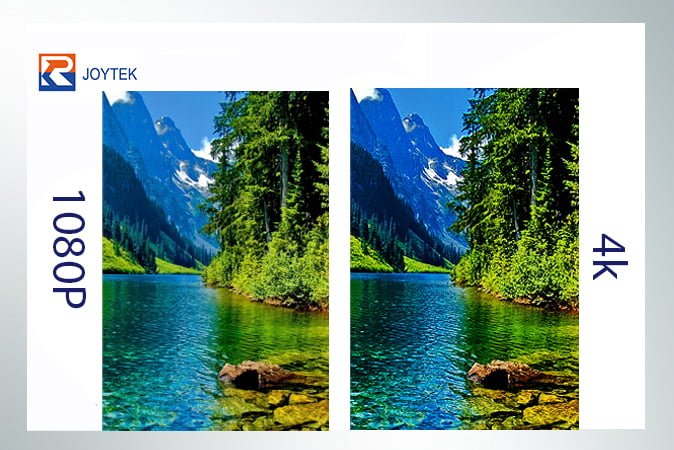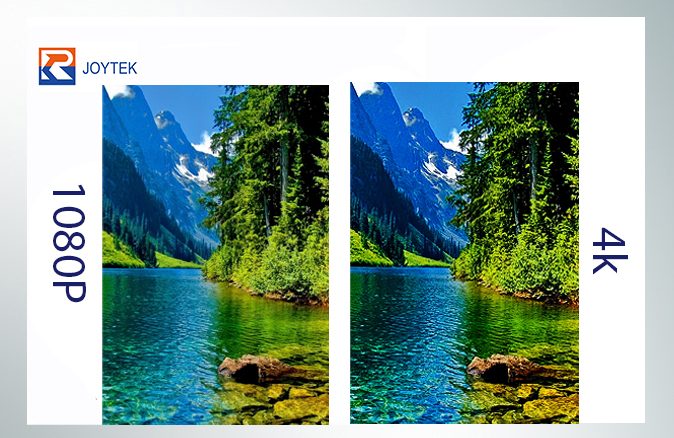In the ever-evolving world of technology, advancements in visual quality have had a profound impact on our entertainment experiences. One of the most significant developments in recent years has been the transition from Full HD (1080p) to 4K resolution in the world of movies. As filmmakers strive to deliver captivating stories with immersive visuals, the debate over whether 4K is truly better than Full HD rages on. In this article, we’ll delve into the key differences between these resolutions and explore whether 4K indeed outshines Full HD in the movie realm.
Understanding the Resolutions:
To comprehend the distinction between 4K and 1080p (full HD), it’s crucial to understand the terminology. Resolution refers to the number of pixels displayed on a screen horizontally and vertically. Full HD (1080p) boasts a resolution of 1920 x 1080 pixels, whereas 4K has a resolution of 3840 x 2160 pixels, approximately four times the pixel count of 1080p. The higher pixel density in 4K results in incredibly sharp and detailed images.

The Impact of 4K in Movies:
Enhanced Detailing: The most apparent advantage of 4K over 1080p lies in the level of detailing it offers. With four times the pixel count, 4K allows for finer textures, intricate patterns, and crisper lines. This heightened level of detail provides a more immersive experience for moviegoers, drawing them deeper into the cinematic world.
Larger Screen Performance: 4K truly shines on larger screens. In theaters or home theaters with massive displays, the higher resolution ensures that the images remain clear and sharp, even when projected onto significant surfaces. This advantage is particularly notable during action-packed sequences, where 4K maintains clarity, reducing the chances of blurred visuals.
Future-Proofing: As technology continues to progress, 4K is rapidly becoming the new standard in visual media. By adopting 4K now, filmmakers ensure their work remains relevant and compatible with future display devices. This forward-thinking approach safeguards the longevity of their creations.
Post-Production Benefits: 4K’s superiority extends to the post-production process. Filmmakers can crop, zoom, and reframe shots without significant loss of quality, offering more flexibility during editing and ensuring the final product looks impeccable on various screen sizes.
Full HD (1080p) Still Holds Its Ground:
While 4K presents numerous advantages, Full HD (1080p) remains a viable and popular choice for several reasons.
Cost Considerations: Shooting and producing movies in 4K can be considerably more expensive than in 1080p. The higher resolution requires more powerful cameras and equipment, as well as increased storage space for the massive video files. For budget-conscious filmmakers, sticking to Full HD may be a more practical option.
Streaming and Bandwidth: 4K videos demand significantly more bandwidth for streaming. With internet infrastructure varying across regions, some audiences may not have the necessary bandwidth to enjoy 4K content without buffering issues. Full HD, on the other hand, is more accessible to a broader audience.
Artistic Intent: The choice between 4K and Full HD may also come down to artistic intent. Some filmmakers deliberately choose 1080p for a specific look or aesthetic that aligns with their storytelling vision.
Application of 4K and 1080P LCD Screen
Applications of 4K (3840 x 2160 pixels):
Movies and Television: 4K has gained significant traction in the entertainment industry, particularly in filmmaking and television production. Major studios and streaming services offer an increasing number of movies, TV shows, and documentaries in 4K, enhancing the overall viewing experience with unparalleled image quality.
Gaming: High-resolution gaming has become a sought-after feature among gamers. Modern gaming consoles and powerful PCs support 4K gaming, allowing players to enjoy visually stunning and immersive gaming environments.
Photography and Video Production: Professional photographers and videographers leverage 4K resolution to capture images and footage with exceptional detail and clarity. This higher resolution offers more flexibility during post-processing and editing, enabling seamless cropping and zooming without sacrificing quality.
Virtual Reality (VR): In the realm of virtual reality, 4K plays a vital role in providing a more realistic and immersive experience. The higher pixel density reduces the so-called “screen-door effect,” enhancing the sense of presence and immersion in virtual environments.
Medical Imaging: In the medical field, 4K resolution is utilized for high-quality medical imaging, including diagnostic imaging, surgical procedures, and educational purposes. This level of detail is critical for accurate analysis and diagnosis.
Applications of 1080p (1920 x 1080 pixels):
Broadcasting: Television broadcasts, especially in traditional cable and satellite TV, are predominantly delivered in 1080p. Many TV channels, news programs, and live events are still broadcast in this resolution.
Video Conferencing: 1080p is widely used in video conferencing platforms and applications. It strikes a balance between video quality and bandwidth consumption, making it suitable for real-time communication.
Online Streaming: While 4K streaming is gaining popularity, 1080p remains the standard for online streaming services due to its lower bandwidth requirements. It ensures smooth playback even for viewers with moderate internet connections.
Web Content and Social Media: For content creators and social media influencers, 1080p videos and images are the go-to choice for online platforms. They strike a balance between quality and file size, making them easily shareable and accessible to a broader audience.
Surveillance Cameras: Many security and surveillance systems use 1080p cameras as they provide sufficient image quality for identifying faces and objects while minimizing storage requirements.
Let’s see what we could provide 1920*1080, 3840*2160 resolution on small size TFT LCD display, some LCD display list reference, more information please contact us!
| Model | Size | Resolution | Interface | Luminance | Active area (mm) |
| RV043FHM-K10-60 | 4.3″ | 1920*1080 | LVDS | 1000nit | 100.8*56.7 |
| RV050FHM-31-K28 | 5″ | 1080*1920 | MIPI | 2800nit | 61.88*110.02 |
| ZTM119BOEE4801 | 11.9″ | 1920*1080 | EDP | 230nit | 263.232(H)*148.068(V) |
| RV133QUM-550-40 | 13.3″ | 3840*2160 | EDP | 500nit | 293.76 *165.24 |
| RV133FHM-300-30 | 13.3″ | 1920*1080 | EDP | 300nit | 293.76 *165.24 |
| ZTM154BOEE5401 | 15.4″ | 1920*1080 | EDP | 220nit | 340.992(H)*191.808(V) |
Conclusion:
In the tug-of-war between 4K and Full HD in the movie realm, there is no definitive answer to whether 4K is inherently better. While 4K undoubtedly provides superior detailing, future-proofing, and excels on larger screens, Full HD remains relevant due to its cost-effectiveness and accessibility.
Ultimately, the decision between 4K and 1080p depends on the filmmaker’s artistic vision, production budget, and target audience. As technology continues to advance, we can expect both resolutions to coexist in the movie industry, each catering to the diverse needs and preferences of filmmakers and viewers alike.
- Products list please check on TFT LCD Display Modul
- Check the LCD Panel Video visit LCD SOLUTION RJY
- If you need engineering support, please contact us

